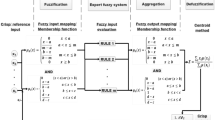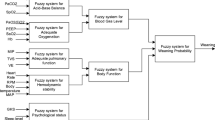Abstract
This study aims to achieve accurate weaning process which is very important for patient under mechanical ventilation. The developed weaning algorithm was designed on LabVIEW software and fuzzy system designer part of LabVIEW software was used during to develop that algorithm. The developed weaning algorithm has six input parameters which are maximum inspiratory pressure (MIP), tidal volume on spontaneous breathing (TVS), minute ventilation (VE), heart rate, respiration per minute (RPM) and body temperature. 20 clinical scenarios were generated by using Monte-Carlo simulations and Gaussian distribution method to evaluate performance of the developed algorithm. An expert clinician was involved to this process to evaluate the each generated clinic scenario to determine weaning probability for the each patient. Student t-test for p < 0.05 was used to show statistical difference between the developed algorithm and clinician’s evaluation. According to student t-test, there is no statistical difference for 98.2 % probability between the developed algorithm and the clinician’s evaluation of weaning probability.
Access this chapter
Tax calculation will be finalised at checkout
Purchases are for personal use only
Similar content being viewed by others
References
Hsu, J.C., Chen, Y.F., Du, Y.D., Huang, Y.F., Jiang, X., Chen, T.: Design of a clinical decision support for determining ventilator weaning using support vector machine. Int. J. Innovative Comput. Inf. Control 8(1(B)), 933–952 (2012)
Brochard, L., Rauss, A., Benito, S., Conti, G., Mancebo, J., Rekik, N., Gasparetto, A., Lemaire, F.: Comparison of three methods of gradual withdrawal from ventilatory support during weaning from mechanical ventilation. Am. J. Respir. Crit. Care Med. 150, 896–903 (1994)
Koyuncu, A., Yava, A., Kurkluoglu, M., Guler, A., Demirkilic, U.: Weaning from mechanical ventilation and nursing. Turk. J. Thorac. Cardiovasc. Surg. 19(4), 671–681 (2011)
Esteban, A., Alia, I., Ibanez, J., et al.: Modes of mechanical ventilation and weaning. A national survey of Spanish hospitals. Chest 106, 1188–1193 (1994)
Bates, J.H.T., Young, M.P.: Applying fuzzy logic to medical decision making in the intensive care unit. Am. J. Respir. Crit. Care Med. 167, 948–952 (2003)
Eskandar, N., Apostolakos, M.J.: Weaning from mechanical ventilation. Crit. Care Clin. 23(2), 263–274 (2007)
MacIntyre, N.R.: Evidence-based guidelines for weaning and discontinuing ventilatory support. Chest 120, 375–396 (2001)
Esteban, A., Frutos, F., Tobin, M.J., Alia, I., Solsona, J.F., Valverdu, I., Fernandez, R., Cal, M.A.D.L., Benito, S., Tomas, R., Carriedo, D., Macias, S., Blanco, J.: A comparison of four methods of weaning patients from mechanical ventilation. N. Engl. J. Med. 332, 345–350 (1995)
Krishnan, J.A., Moore, D., Robeson, C., Rand, C.S., Fessler, H.E.: A Prospective, controlled trial of a protocol-based strategy to discontinue mechanical ventilation. Am. J. Respir. Crit. Care Med. 169, 673–678 (2004)
Guler, H., Ata, F.: Development of a fuzzy-based tidal volume algorithm for patients with respiratory distress. J. Fac. Eng. Archit. Gazi Univ. 29(4), 699–706 (2014)
Bien, M.Y., Lin, Y.S., Shie, H.G., Yang, Y.L., Shih, C.H., Wang, J.H., Cheng, K.C.: Rapid Shallow Breathing Index and Its predictive accuracy measured under five different ventilatory strategies in the same patient group. Chin. J. Physiol. 53(1), 1–10 (2010)
Yang, K.L., Tobin, M.J.: A prospective study of indexes predicting the outcome of trials of weaning from mechanical ventilation. N Engl. J. Med. 324, 1445–1450 (1991)
Bien, M.Y., Hseu, S.S., Yien, H.W., Kuo, B.I., Lin, Y.T., Wang, J.H., Kou, Y.R.: Breathing pattern variability: a weaning predictor in postoperative patients recovering from systemic inflammatory response syndrome. Intensive Care Med. 30(2), 241–247 (2004)
Vassilakopoulos, T., Zakynthinos, S., Roussos, C.: The tension-time index and the frequency/tidal volume ratio are the major pathophysiologic determinants of weaning failure and success. Am. J. Respir. Crit. Care Med. 158(2), 378–385 (1998)
Bellemare, F., Grasino, A.: Effect of pressure and timing of contraction of the human diaphragm fatigue. J. Appl. Physiol. 53, 1190–1195 (1982)
Nemoto, T., Hatzakis, G.E., Thorpe, C.W., Olivenstein, R., Dial, S., Bates, J.H.T.: Automatic control of pressure support mechanical ventilation using fuzzy logic. Am. J. Respir. Crit. Care Med. 160(2), 550–556 (1999)
Alia, I., Esteban, A.: Weaning from mechanical ventilation. Crit. Care 4(2), 72–80 (2000)
Butler, R., Keenan, S.P., Inman, K.J., Sibbald, W.J., Block, G.: Is there a preferred technique for weaning the difficult to wean patient? A systematic review of the literature. Crit. Care Med. 27(11), 2331–2336 (1999)
Ely, E.W., et al.: Effect on the duration of mechanical ventilation of identifying patients capable of breathing spontaneously. N Eng. J. Med. 335(25), 1864–1869 (1996)
Kilic, Y.A., Kilic, I.: A novel fuzzy logic inference system for decision support in weaning from mechanical ventilation. J. Med. Syst. 34(6), 1089–1095 (2010)
Wannenburg, J., Malekian, R.: Body sensor network for mobile health monitoring a diagnosis and anticipating system. IEEE Sens. J. 15(12), 6839–6852 (2015)
Wannenburg, J., Malekian, R.: Physical activity recognition from smartphone accelerometer data for user context awareness sensing. IEEE Trans. Syst. Man Cybern. Syst. PP(99), 1–8 (2016)
Kroese, D.P., Brereton, T., Taimre, T., Botev, Z.I.: Why the Monte Carlo method is so important today. WIREs Comput. Stat. 6, 386–392 (2014)
Guler, H., Turkoglu, I., Ata, F.: Designing intelligent mechanical ventilator and user interface using LabVIEW (R). Arab. J. Sci. Eng. 39(6), 4805–4813 (2014)
Guler, H., Ata, F.: Design of a fuzzy-labview-based mechanical ventilator. Comput. Syst. Sci. Eng. 29(3), 219–229 (2014)
Guler, H., Ata, F.: The comparison of manual and LabVIEW-based fuzzy control on mechanical ventilation. Proc. Inst. Mech. Eng. Part H-J. Eng. Med. 228(9), 916–925 (2014)
Guzel, S., Kaya, T., Guler, H.: LabVIEW -based analysis of EEG signals in determination of sleep stages. In: 23th Signal Processing and Communications Applications Conference (SIU), pp. 799–802 (2015)
Acknowledgements
This study is part of a project funded by FUBAP grant no. MF.13.21 and HUBAP grant no. 15130. The authors would like to thank Firat University Hospital-Anesthesia ICU doctors for their invaluable evaluations.
Author information
Authors and Affiliations
Corresponding author
Editor information
Editors and Affiliations
Rights and permissions
Copyright information
© 2016 Springer International Publishing Switzerland
About this paper
Cite this paper
Kilic, U., Gulluoglu, M.T., Guler, H., Kaya, T. (2016). Analysis of Pulmonary and Hemodynamic Parameters for the Weaning Process by Using Fuzzy Logic Based Technology. In: Dregvaite, G., Damasevicius, R. (eds) Information and Software Technologies. ICIST 2016. Communications in Computer and Information Science, vol 639. Springer, Cham. https://doi.org/10.1007/978-3-319-46254-7_10
Download citation
DOI: https://doi.org/10.1007/978-3-319-46254-7_10
Published:
Publisher Name: Springer, Cham
Print ISBN: 978-3-319-46253-0
Online ISBN: 978-3-319-46254-7
eBook Packages: Computer ScienceComputer Science (R0)




